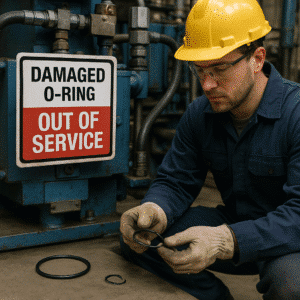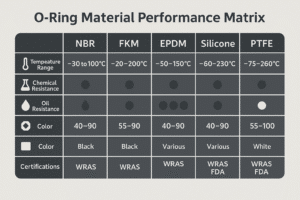Choosing the wrong oil seal material can cause leaks, failures, and costly downtime.
FKM offers superior performance in high heat and chemical resistance. NBR is more affordable and flexible in low-temperature environments.
Let’s break down how to compare them—by temperature, fluid compatibility, durability, and price.
What are the key differences between FKM and NBR oil seals?
Understanding performance gaps helps you pick the right material for the job.
FKM resists heat and chemicals better, while NBR performs well under moderate conditions and costs less.
| Recurso | FKM | NBR |
|---|---|---|
| Faixa de temperatura | -26°C to +205°C | -40°C a +120°C |
| Resistência química | Excelente | Bom |
| Resistência ao desgaste | Bom | Excelente |
| Custo | Mais alto | Mais baixo |
| Melhor para | High-temp/chemical exposure | Sistemas hidráulicos gerais |
FKM is ideal for fuel systems, chemical pumps, and high-speed motors. For general maintenance, Anéis de vedação NBR remain the most popular choice.
How do temperature ranges compare between FKM and NBR?
Temperature extremes affect seal life and function.
FKM maintains shape and elasticity up to +205°C. NBR remains flexible down to -40°C, ideal for cold-weather equipment.
| Material | Min Temp | Temperatura Máxima |
|---|---|---|
| FKM | -26°C | +205°C |
| NBR | -40°C | +120°C |
If your system runs hot, Anéis de vedação FKM will ensure longer service life.
Which material offers better chemical resistance?
FKM outperforms NBR in aggressive environments.
It resists oils, fuels, acids, and many solvents, while NBR is limited to petroleum-based fluids.
| Tipo de fluido | FKM | NBR |
|---|---|---|
| Óleo mineral | ✔️ | ✔️ |
| Fuel | ✔️ | ✔️ |
| Ácidos | ✔️ | ⚠️ |
| Cetonas | ⚠️ | ❌ |
| Coolants | ✔️ | ⚠️ |
Anéis de vedação FKM are often used in fuel injectors and chemical pumps, where failure isn’t an option.
How do FKM and NBR compare in terms of cost?
NBR offers solid performance at low cost. FKM delivers premium protection but with higher upfront investment.
| Material | Relative Cost | Vida útil |
|---|---|---|
| FKM | Mais alto | Long |
| NBR | Mais baixo | Moderado |
Looking for both economy and safety? Consider dual-material kits for mixed systems.
Conclusão
FKM excels in heat and chemical resistance; NBR wins on affordability and cold weather use.
Need Help Choosing Your Oil Seal?
📩 E-mail: [email protected]
📱 WhatsApp: +86 17622979498
Related topic


